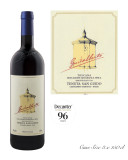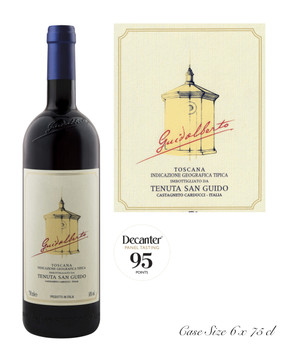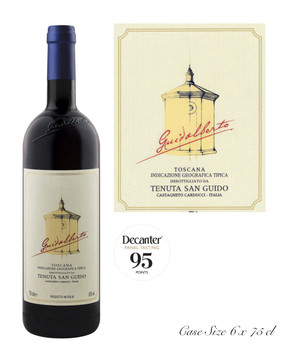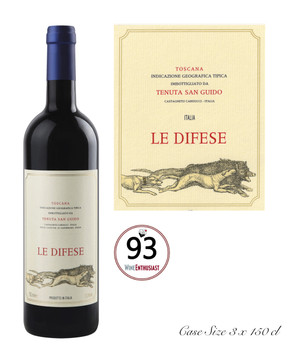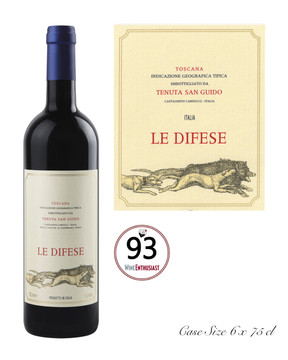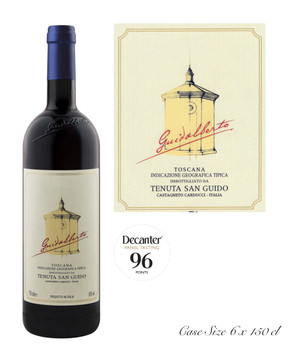
Tenuta San Guido Guidalberto Magnum 2022.
The new millennium at the estate was marked by the birth of Guidalberto: 2000 was the first vintage to be bottled. The label portrays the oratory of San Guido, property of Tenuta San Guido, and the name of the wine refers to an Incisa family ancestor, Guidalberto della Gherardesca, a pioneer of the agricultural conversion of the Bolgheri area during the 19th century.
After more than twenty years of careful analysis and experiments, Guidalberto, a blend of Cabernet Sauvignon and Merlot, today Guidalberto represents a true interpretation of its place of origin. Whilst it embraces a younger style than its sister Sassicaia, it’s age ability is also undisputed. With Merlot-led aromas and sweetness on the palate, it leans on a classic Cabernet structure to ensure graceful ageing in bottle.
Guidalberto has its own distinct character from Sassicaia, conceived by the second generation of the Incisa family; if Sassicaia was created by the vision of Mario Incisa della Rocchetta, Guidalberto is the result of the vision of his son, Nicolò. The debut 2000 vintage showcased the wine’s fantastic noble breeding, which today is reaping the rewards of impressive ageing potential.
THE 2022 VINTAGE: The 2022 vintage was rather warm, although in Bolgheri and especially on the hills the situation was different compared to other areas of Italy and Tuscany. Autumn brought abundant rains with above-normal temperatures, which dropped significantly from the end of November and throughout December, with night temperatures often dropping below 0°C, causing the plants to go into vegetative rest and the natural elimination of vine parasites. From the end of December, temperatures rose again. The rains continued in January and mid-February, when cold temperatures close to 0°C returned, for a few days.
From the end of February, temperatures rose rapidly creating conditions of high humidity. This was followed by an unusual March, with mild temperatures and no rain. A situation which, especially in the lower areas of the estate, anticipated the swelling of the buds. In the very first days of April, a sudden drop in temperature caused a modest bud selection in some vineyards containing the more precocious ripening varieties. From mid May the temperature increased suddenly to above the seasonal average, both during the day and at night. These conditions, in the delicate moment of flowering and fruit setting, led to strong selection and, consequently, reduced production. The summer was warm and dry, often above the seasonal average, however, the microclimate of the area (proximity to the sea, strong ventilation, and wide diurnal range) helped the plants and resulted in an excellent quality crop. The weather conditions that affected the various parts of the growing season did not always positively influence the phenological phases of the vine.
However, the lower production per plant and the sparser bunches helped the plants to maintain the production and complete ripening, while avoiding stressful conditions. The intense heat lasted until mid-August, after which the rain came, bringing a drop in temperature.
THE 2022 VINTAGE: The 2022 vintage was challenging, and not especially generous in quantity, but the grapes from the hillside vineyards were excellent with great balance of total acidity and not excessive alcohol content. Le Difese 2022 shows a beautiful intensity of fruit, softness, and pleasantness of well-integrated tannins. For Guidalberto 2022 brought the average age of the vineyards dedicated to its production to 18 years old. The Merlot in the blend imparts a soft elegance and lively notes of fresh fruit that perfectly complement the flair and verticality of Cabernet Sauvignon.
Careful sorting of the grapes in the field during harvesting by hand and further selection upon arrival in the cellar using a sorting table. In the winery, the grapes were destemming and soft pressed to limit the release of tannins and maintain maximum elegance. The alcoholic fermentation was carried out in stainless steels tanks at a controlled temperature followed by macerations for approximately 11-13 days for the Merlot and approximately 15-16 days for the Cabernet Sauvignon.
Frequent pumping over, while racking was carried out to a lesser extent than in other vintages, to obtain a greater balance and favour primary aromatic extraction. The malolactic fermentation started spontaneously at the end of October, following which the musts were decanted to eliminate sediments and maintain maximum cleanliness. The musts were then transferred to 225-liter barriques (partly French oak and a small part (5%) of American oak) from the second half of November. The ageing choices were made to best balance the release of tannins and, at the same time, keep in the foreground the excellent primary and secondary aromas obtained from a great vintage in a good part of the musts.
The new millennium at the estate was marked by the birth of Guidalberto: 2000 was the first vintage to be bottled. The label portrays the oratory of San Guido, property of Tenuta San Guido, and the name of the wine refers to an Incisa family ancestor, Guidalberto della Gherardesca, a pioneer of the agricultural conversion of the Bolgheri area during the 19th century.
After more than twenty years of careful analysis and experiments, Guidalberto, a blend of Cabernet Sauvignon and Merlot, today Guidalberto represents a true interpretation of its place of origin. Whilst it embraces a younger style than its sister Sassicaia, it’s age ability is also undisputed. With Merlot-led aromas and sweetness on the palate, it leans on a classic Cabernet structure to ensure graceful ageing in bottle.
Guidalberto has its own distinct character from Sassicaia, conceived by the second generation of the Incisa family; if Sassicaia was created by the vision of Mario Incisa della Rocchetta, Guidalberto is the result of the vision of his son, Nicolò. The debut 2000 vintage showcased the wine’s fantastic noble breeding, which today is reaping the rewards of impressive ageing potential.
THE 2022 VINTAGE: The 2022 vintage was rather warm, although in Bolgheri and especially on the hills the situation was different compared to other areas of Italy and Tuscany. Autumn brought abundant rains with above-normal temperatures, which dropped significantly from the end of November and throughout December, with night temperatures often dropping below 0°C, causing the plants to go into vegetative rest and the natural elimination of vine parasites. From the end of December, temperatures rose again. The rains continued in January and mid-February, when cold temperatures close to 0°C returned, for a few days.
From the end of February, temperatures rose rapidly creating conditions of high humidity. This was followed by an unusual March, with mild temperatures and no rain. A situation which, especially in the lower areas of the estate, anticipated the swelling of the buds. In the very first days of April, a sudden drop in temperature caused a modest bud selection in some vineyards containing the more precocious ripening varieties. From mid May the temperature increased suddenly to above the seasonal average, both during the day and at night. These conditions, in the delicate moment of flowering and fruit setting, led to strong selection and, consequently, reduced production. The summer was warm and dry, often above the seasonal average, however, the microclimate of the area (proximity to the sea, strong ventilation, and wide diurnal range) helped the plants and resulted in an excellent quality crop. The weather conditions that affected the various parts of the growing season did not always positively influence the phenological phases of the vine.
However, the lower production per plant and the sparser bunches helped the plants to maintain the production and complete ripening, while avoiding stressful conditions. The intense heat lasted until mid-August, after which the rain came, bringing a drop in temperature.
THE 2022 VINTAGE: The 2022 vintage was challenging, and not especially generous in quantity, but the grapes from the hillside vineyards were excellent with great balance of total acidity and not excessive alcohol content. Le Difese 2022 shows a beautiful intensity of fruit, softness, and pleasantness of well-integrated tannins. For Guidalberto 2022 brought the average age of the vineyards dedicated to its production to 18 years old. The Merlot in the blend imparts a soft elegance and lively notes of fresh fruit that perfectly complement the flair and verticality of Cabernet Sauvignon.
Careful sorting of the grapes in the field during harvesting by hand and further selection upon arrival in the cellar using a sorting table. In the winery, the grapes were destemming and soft pressed to limit the release of tannins and maintain maximum elegance. The alcoholic fermentation was carried out in stainless steels tanks at a controlled temperature followed by macerations for approximately 11-13 days for the Merlot and approximately 15-16 days for the Cabernet Sauvignon.
Frequent pumping over, while racking was carried out to a lesser extent than in other vintages, to obtain a greater balance and favour primary aromatic extraction. The malolactic fermentation started spontaneously at the end of October, following which the musts were decanted to eliminate sediments and maintain maximum cleanliness. The musts were then transferred to 225-liter barriques (partly French oak and a small part (5%) of American oak) from the second half of November. The ageing choices were made to best balance the release of tannins and, at the same time, keep in the foreground the excellent primary and secondary aromas obtained from a great vintage in a good part of the musts.



